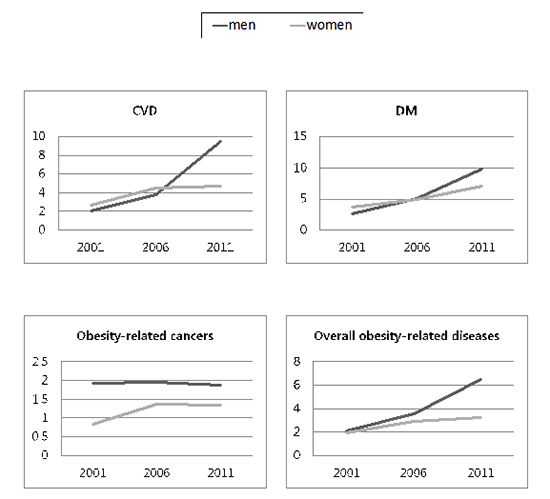1. McLaren L. Socioeconomic status and obesity. Epidemiol Rev. 2007; 29:29–48.
2. Song YM. Commentary: varying relation of socioeconomic status with obesity between countries at different stages of development. Int J Epidemiol. 2006; 35:112–113.
3. Dinsa GD, Goryakin Y, Fumagalli E, Suhrcke M. Obesity and socioeconomic status in developing countries: a systematic review. Obes Rev. 2012; 13:1067–1079.
4. Monteiro CA, Moura EC, Conde WL, Popkin BM. Socioeconomic status and obesity in adult populations of developing countries: a review. Bull World Health Organ. 2004; 82:940–946.
5. Maier W, Scheidt-Nave C, Holle R, Kroll LE, Lampert T, Du Y, Heidemann C, Mielck A. Area level deprivation is an independent determinant of prevalent type 2 diabetes and obesity at the national level in Germany. Results from the National Telephone Health Interview Surveys ‘German Health Update’ GEDA 2009 and 2010. PLoS One. 2014; 9:e89661.
6. Saydah S, Lochner K. Socioeconomic status and risk of diabetes-related mortality in the U.S. Public Health Rep. 2010; 125:377–388.
7. Song YM, Ferrer RL, Cho SI, Sung J, Ebrahim S, Davey Smith G. Socioeconomic status and cardiovascular disease among men: the Korean national health service prospective cohort study. Am J Public Health. 2006; 96:152–159.
8. Oh SW. Obesity and metabolic syndrome in Korea. Diabetes Metab J. 2011; 35:561–566.
10. Sagar AD, Najam A. The human development index: a critical review. Ecol Econ. 1998; 25:249–264.
11. Flegal KM, Graubard BI, Williamson DF, Gail MH. Cause-specific excess deaths associated with underweight, overweight, and obesity. JAMA. 2007; 298:2028–2037.
13. Song DK, Sung YA. Obesity: introduction. Korean J Med. 2013; 84:619–623.
14. Hayes LJ, Berry G. Sampling variability of the Kunst-Mackenbach relative index of inequality. J Epidemiol Community Health. 2002; 56:762–765.
15. Vathesatogkit P, Batty GD, Woodward M. Socioeconomic disadvantage and disease-specific mortality in Asia: systematic review with meta-analysis of population-based cohort studies. J Epidemiol Community Health. 2014; 68:375–383.
16. Stringhini S, Rousson V, Viswanathan B, Gedeon J, Paccaud F, Bovet P. Association of socioeconomic status with overall and cause specific mortality in the Republic of Seychelles: results from a cohort study in the African region. PLoS One. 2014; 9:e102858.
17. Arroyave I, Burdorf A, Cardona D, Avendano M. Socioeconomic inequalities in premature mortality in Colombia, 1998-2007: the double burden of non-communicable diseases and injuries. Prev Med. 2014; 64:41–47.
18. Collier A, Ghosh S, Hair M, Waugh N. Impact of socioeconomic status and gender on glycaemic control, cardiovascular risk factors and diabetes complications in type 1 and 2 diabetes: a population based analysis from a Scottish region. Diabetes Metab. 2015; 41:145–151.
19. Mulvaney-Day N, Womack CA. Obesity, identity and community: leveraging social networks for behavior change in public health. Public Health Ethics. 2009; 2:250–260.
20. Kaufman L, Karpati A. Understanding the sociocultural roots of childhood obesity: food practices among Latino families of Bushwick, Brooklyn. Soc Sci Med. 2007; 64:2177–2188.
21. Gordon-Larsen P, Nelson MC, Page P, Popkin BM. Inequality in the built environment underlies key health disparities in physical activity and obesity. Pediatrics. 2006; 117:417–424.
22. Giles-Corti B, Donovan RJ. Relative influences of individual, social environmental, and physical environmental correlates of walking. Am J Public Health. 2003; 93:1583–1589.
23. Kant AK, Graubard BI. Family income and education were related with 30-year time trends in dietary and meal behaviors of American children and adolescents. J Nutr. 2013; 143:690–700.
24. Kim MY, Oh JK, Lim MK, Yun EH, Kang YH. The Association of socioeconomic and psychosocial factors with obesity in a rural Community. Korean J Obes. 2012; 21:18–28.
25. Kim J, Sharma SV, Park SK. Association between socioeconomic status and obesity in adults: evidence from the 2001 to 2009 Korea National Health and Nutrition Examination Survey. J Prev Med Public Health. 2014; 47:94–103.
26. Paek E, Kim J. The relationship between educational attainment and obesity among Korean adults : focusing on age variations. J Korean Soc Health Educ Promot. 2013; 30:91–100.
27. Yoo S, Cho HJ, Khang YH. General and abdominal obesity in South Korea, 1998-2007: gender and socioeconomic differences. Prev Med. 2010; 51:460–465.
28. Kim YM, Jung-Choi K. Socioeconomic inequalities in health risk factors in Korea. J Korean Med Assoc. 2013; 56:175–183.
29. Cho HJ. Equity in health care: current situation in South Korea. J Korean Med Assoc. 2013; 56:184–194.
30. Cha SH, Park HS, Cho HJ. Socioeconomic disparities in prevalence, treatment, and control of hypertension in middle-aged Koreans. J Epidemiol. 2012; 22:425–432.
31. Tamayo T, Claessen H, Rückert IM, Maier W, Schunk M, Meisinger C, Mielck A, Holle R, Thorand B, Narres M, et al. Treatment pattern of type 2 diabetes differs in two German regions and with patients’ socioeconomic position. PLoS One. 2014; 9:e99773.
32. Franco M, Bilal U, Orduñez P, Benet M, Morejón A, Caballero B, Kennelly JF, Cooper RS. Population-wide weight loss and regain in relation to diabetes burden and cardiovascular mortality in Cuba 1980-2010: repeated cross sectional surveys and ecological comparison of secular trends. BMJ. 2013; 346:f1515.
33. Seubsman SA, Lim LL, Banwell C, Sripaiboonkit N, Kelly M, Bain C, Sleigh AC. Socioeconomic status, sex, and obesity in a large national cohort of 15-87-year-old open university students in Thailand. J Epidemiol. 2010; 20:13–20.
34. Zhang Q, Wang Y. Socioeconomic inequality of obesity in the United States: do gender, age, and ethnicity matter? Soc Sci Med. 2004; 58:1171–1180.
35. Canning KL, Brown RE, Jamnik VK, Kuk JL. Relationship between obesity and obesity-related morbidities weakens with aging. J Gerontol A Biol Sci Med Sci. 2014; 69:87–92.
36. Frederick CB, Snellman K, Putnam RD. Increasing socioeconomic disparities in adolescent obesity. Proc Natl Acad Sci USA. 2014; 111:1338–1342.
37. Kim MH, Jung-Choi K, Kim H, Song YM. Educational inequality in female cancer mortality in Korea. J Korean Med Sci. 2015; 30:1–6.
40. Skibba RM, Gourley WK, Klotz AP. Early detection and prevention of colon cancer. The role of colonscopy. Arch Intern Med. 1976; 136:890–892.







 PDF
PDF ePub
ePub Citation
Citation Print
Print




 XML Download
XML Download